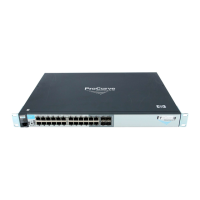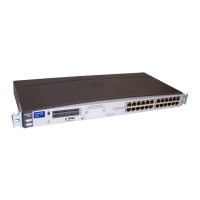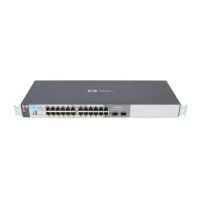Port Traffic Controls
Rate-Limiting
Operating Notes for Rate-Limiting
■ Rate-limiting operates on a per-port basis, regardless of traffic
priority. Rate-limiting is available on all types of ports (other than trunked
ports) on the switches covered in this guide, and at all port speeds
configurable for these devices.
■ Rate-limiting is not allowed on trunked ports: Rate-limiting is not
supported on ports configured in a trunk group (including mesh ports).
Configuring a port for rate-limiting and then adding it to a trunk suspends
rate-limiting on the port while it is in the trunk. Attempting to configure
rate-limiting on a port that already belongs to a trunk generates the
following message:
< port-list >: Operation is not allowed for a trunked port.
■ Rate-limiting for inbound and outbound traffic are separate
features: The rate limits for each direction of traffic flow on the same
port are configured separately—even the specified limits can be different.
■ Rate-limiting is visible as an outbound forwarding rate: Because
inbound rate-limiting is performed on packets during packet-processing,
it is not shown via the inbound drop counters. Instead, this limit is
verifiable as the ratio of outbound traffic from an inbound rate-limited
port versus the inbound rate. For outbound rate-limiting, the rate is visible
as the percentage of available outbound bandwidth (assuming that the
amount of requested traffic to be forwarded is larger than the rate-limit).
■ Operation with other features: Configuring rate-limiting on a port
where other features affect port queue behavior (such as flow control)
can result in the port not achieving its configured rate-limiting maximum.
For example, in a situation where flow control is configured on a rate-
limited port, there can be enough “back pressure” to hold high-priority
inbound traffic from the upstream device or application to a rate that is
lower than the configured rate limit. In this case, the inbound traffic flow
does not reach the configured rate and lower priority traffic is not
forwarded into the switch fabric from the rate-limited port. (This behavior
is termed “head-of-line blocking” and is a well-known problem with flow-
control.) In another type of situation, an outbound port can become
oversubscribed by traffic received from multiple rate-limited ports. In this
case, the actual rate for traffic on the rate-limited ports may be lower than
configured because the total traffic load requested to the outbound port
exceeds the port’s bandwidth, and thus some requested traffic may be held
off on inbound.
13-8
